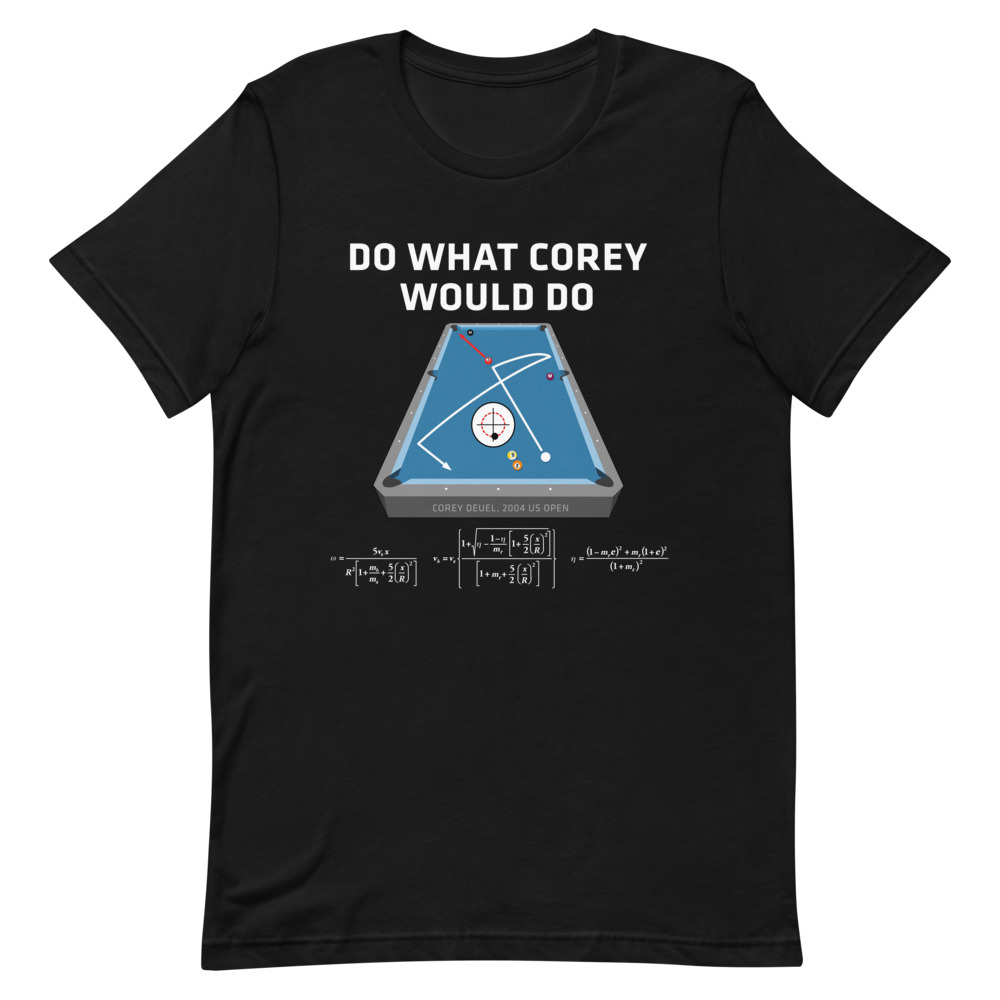Here’s a bio and summary of Dr. Dave’s contributions to the pool world and here are some background articles:
- Colorado State University magazine article: “Racking Up the Physics of Pool.”
- BCA Insider magazine article: “Dr. Dave Alciatore Takes Home Jerry Briesath Instructor of the Year Award.”
Here are podcasts dealing with billiards and bowling physics with the famous astrophysicist Neil deGrasse Tyson:
Here are some other podcast interviews, most from American Billiard Radio (ABR) :
- “The Run-Out Drill System (RDS) (Feb, 2021).
- “Can you earn a higher grade than Shane Van Boening?” dealing with the $4000 BU Exam I 100 Challenge (April, 2018).
- “The Doctor Is In” dealing with the Video Encyclopedia of Eight Ball (VEEB) (Aug, 2015).
- “Team USA Profile #3 – Sossei” dealing with the Billiard University (BU) and the Billiard Education Foundation (BEF) (May, 2014).
Here’s a video interview and lesson with Rollie Williams:
And here’s a two-part interview with Dr. Dave discussing various pool topics:
And here’s a tour of his pool room and studio:
Dr. Dave is a retired mechanical engineering professor (1991-2020) from Colorado State University in Fort Collins, Colorado. Here’s a video interview dealing with how Dr. Dave incorporated his passion for pool into the engineering classroom:
Answers to various questions I’ve been asked over the years are summarized below.
Why do people call you Dr. Dave? Are you a “real” doctor?
I am not a medical doctor (MD); although, I do stay at Holiday Inn Expresses on occasion (an old joke). I have a PhD in mechanical engineering, which is where the “Dr.” first came from. I also have a Doctorate of Pool (DP) from the Billiard University. My friends and students starting calling me “Dr. Dave” soon after I got my PhD, and it just stuck. That’s what everybody in the pool world calls me too. I’ve always liked the less-formal-sounding nickname, compared to “Dr. Alciatore.”
How and when did you get into billiards/pool, and what do you find intriguing about it?
I started playing when I was very young. I spent lots of time in a bowling alley (“misspent youth”) in New Orleans where my mother worked for many years. I spent many afternoons bowling and playing pool, pinball, and video games (when they started coming out). We also had a very cheap but fun pool table at home when I was young. Here’s the earliest pool photo I have of me … I’m in the bottom-left with the white shirt watching my older brother shoot:
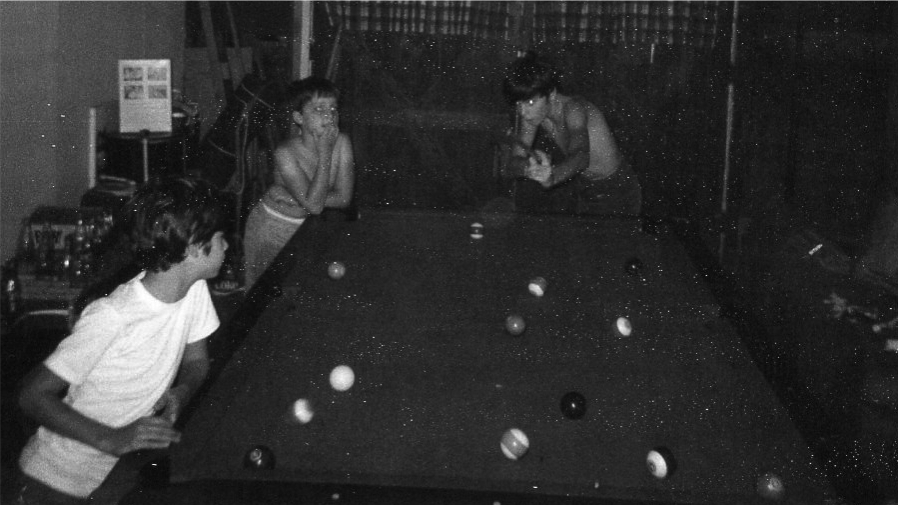
I also played lots of pool with buddies when I was in graduate school in Austin, Texas. I have lots of fond memories from those days. Pool with friends is a great stress reliever.
I got more serious about pool in the late 90’s when I joined a pool league while I was living in Washington D.C. for a year. There were many great players (and serious gamblers) in the league. I would often ask them questions to try to learn as much as I could from them. One thing I learned is that many players (even some good ones) often don’t truly understand how to plan and execute shots and run-outs. I also learned that many people willing to give advice often do poor jobs at trying to teach and help others apply the important basic principles of pool. Around the same time, I also started reading all instructional pool books available, because I wanted to improve so I could try to compete with those great players. In reading the books, I was often disappointed by how poorly some of them were written and illustrated. Many of them also described things wrongly from a physics perspective. That’s when I started thinking about writing my own pool book that would cover all the important principles, be very well illustrated and easy to read, and be supported by lots of great web resources (mostly video demonstrations). That’s when I truly became passionate about the game.
Being a mechanical engineer, I also love the physics of the game:
What did your typical day as Mechanical Engineering professor consist of?
I prepared for classes, gave lectures, helped and mentored students that visited my office, dropped in on Lab courses to make sure things are running smoothly and to answer student questions, wrote technical papers (for journals and conferences) and pool articles (for Billiards Digest), read articles and books supporting my research and pool interests, responded to e-mails from students and pool enthusiasts, responded to messages posted on the AZBilliards online discussion forum, maintained and expanded all my websites (pool and engineering related), served on university committees (e.g., to make changes in curriculum and hire new people), did volunteer work for the American Society for Mechanical Engineers (ASME), planned trips (e.g., for the “Illustrated Principles of Pool and Billiards” talk that I gave around the country), and planned, thought about, and did work on my “mechatronics” textbook (dealing with electronics for mechanical engineers) and future pool instruction projects. In my spare time, I also gave individual pool lessons and ran an annual Boot Camps for the Billiard University.
Here’s a video interview dealing with how I incorporated my passion for pool into the engineering classroom.
And here’s my professional website with links to everything I have done.
Do you teach billiards/pool to individuals in a unique or different way?
I certainly have a more high-tech approach than many pool instructors. For example, I do detailed video analysis of each student’s technique. I also help the students learn to understand what they are doing and why and how certain things work or don’t work at the table. Some instructors just tell them what to do. I think my approach is better in the long run … and more fun.
What should an individual expect when attending one of your pool courses?
With both a private lesson from the Dr. Dave Pool School or a groups course from the Billiard University Boot Camps, students should expect to:
- Learn how to play pool better.
- Have fun, get more excited about the game, and develop a desire to learn more.
- Leave with a plan and tools for continuous improvement.
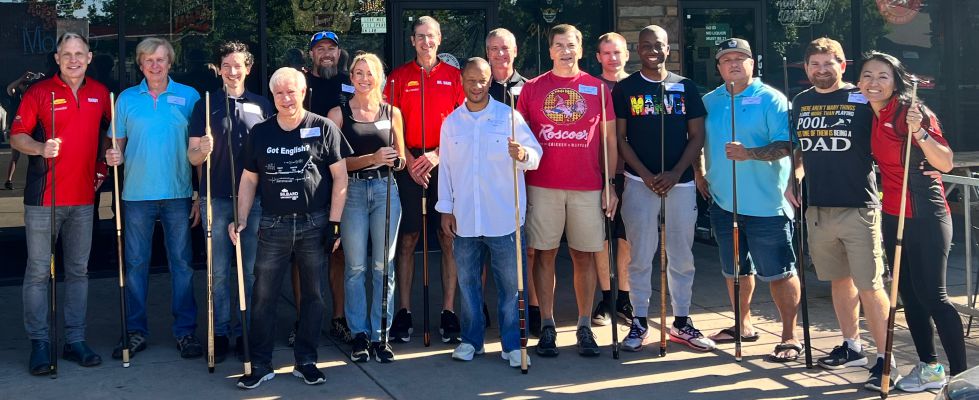
How did you start with the idea of writing your pool book?
In 1999-2000, I was alone on sabbatical in Washington DC and I joined a pool league with lots of great players. I wanted to improve my game so I started reading pool books and watching instructional videos. I also tried to learn as much as I could from the top players in the league. Honestly, I was very disappointed with the lack of quality and completeness of many of the books and videos available at that time. Many concepts were explained incorrectly from a physical perspective, and the illustrations were not always done well. During my learning process, I started keeping a folder of ideas and notes; and after a while, the folder started to get really thick. At that point, I thought I should write my own book and try to come up with something better than what was already available.
Luckily, through a friend who had already published books, I had a contact at Barnes&Noble and I sent him a proposal for “The Illustrated Principles of Pool and Billiards.” I was obviously thrilled when B&N decided to publish my book. After that point, I thought about the project daily and constantly mulled ideas over in my mind, and often bounced ideas off pool friends to get input and recommendations. I started with a complete and detailed outline of the book, based on all the ideas and example shots on the scraps of paper and bar napkins in the folder I mentioned above. Then I drew all the illustrations for the book. Then the book almost wrote itself.
It takes a lot of dedication to write a book, did it take you a while to complete, and what was involved?
I thought about the book, kept the folder of ideas, and did research over about 4 years (but not full time). The actual writing took about 5 months over 2 summers. The website work supporting the book took about 1 solid month of work. The most time-consuming part of writing the book was developing, drawing, and verifying all the illustrations. This can sometimes be tedious and it required me to develop proficiency with a computer drawing program (I used CorelDraw).
Why might it be worthwhile for individuals who know little about this game to learn and play?
Pool is a great sport and activity. You can play it your whole life and never get bored. There is always something new to learn. Most importantly, it is lots of fun playing with others. Also, you don’t need to be good to enjoy playing. Even a person who has never played before can pick up a cue and have fun the first time they hit a ball (even if the ball doesn’t go in the pocket). This can’t be said for most sports. And with a little instruction, a person can quickly learn to play much better and enjoy the game even more, especially when they show off their new-found skills to friends and family.
Do you practice a lot, and what do you do for practice?
I don’t practice near as much as I would like. I usually only find time to play a couple of times a week for 1-3 hours each time. I usually just play 8-ball or 9-ball with friends. When I practice alone, I run racks of 9-ball, 10-ball, or 15-ball, starting with ball in hand after the break. Any time I miss a shot or play poor position, I try the shot over and over again until I am happy with the results and confident I can do better the next time I face such a shot. Sometimes I just practice safeties and follow-on reply shots, because these are critically important component of intelligent pool. If I feel I am not doing very well during practice or after playing with friends, I always go back to checking my fundamentals: making sure my stance and stroke are comfortable and consistent, and making sure no bad habits have popped up in my game (e.g., dropping the elbow, not pausing before the final stroke, moving my head or body during a shot, steering the follow-through, etc.). I also find the Billiard University playing-ability Exams helpful in working on and improving fundamentals. I also try to do all the stuff recommend on the my practice advice resource page.
What are the top three skills that a person must learn to win games?
- aiming and visualization skills (this is part natural talent and part practice).
- consistent stoke (be able to hit the cue ball at the desired contact point and in the desired direction).
- speed control and solid strategy and decision making.
The most important factor in improving is having fun. That’s why the word “FUN” is in “FUNdamentals.” The mental side of the game is also important (per fundaMENTALs); so when playing, try to stay focused and really concentrate when aiming a shot. Also, learn from your mistakes, try to stay positive, and work hard to improve your knowledge and understanding of our wonderful sport by reading books, watching videos, and working with qualified and experienced instructors. For more info, see the how to improve resource page.
What do you think is the most important fundamental of pool?
… consistent and accurate head alignment. If your eyes are not in the right place over the cue, your aim will be off and the CB will not head in the direction you think … even with a perfect stroke. For more info, see the vision center resource page. Stroke “best practices” and accurate aiming are also very important, along with a strong mental game (see the next section).
What do you think about the mental skills a player must have?
… confidence and positive thoughts, realistic appraisal and understanding of one’s ability, concentration and focus, dedication and desire to practice and get better, ability to not be influenced or emotionally affected by factors out of your control (e.g., a lucky or distracting opponent), motivation for and love of the game. I cover a lot more in the following video and on the mental game resource page:
Is 8-ball your favorite billiard game?
Yes. I especially love “bar box” 8-ball. I also like 15-ball rotation. I like the sometimes chess-like strategy involved with 8-ball and the shot-making and position play challenges of 15-ball.
What is your favorite pool film?
“The Color of Money.” The movie was very well done with good acting, cinematography, plot, and music, and it also helped glamorize our sport and dramatically increases its popularity.
What are your favorite pool T-shirts?
… all the shirts available here: DrDaveBilliardTshirts.com. Here are some examples:
Do you play any other sports?
- bowling (I’ve bowled a perfect game [300] and have averaged above 215).
- table tennis (I’ve played seriously on and off over the years).
- running (I ran track and cross country in college [The University of New Orleans]).
- hiking, biking (road and mountain), and skiing. Colorado is great for these things.
Why do you use the tagline “I aim to swerve”?
To be cute. It is a play on words based on the phrase “I aim to serve” (which I do with my hard work). “Swerve” is the curve of a CB’s path when sidespin is used, and one must compensate for this when you “aim” a pool shot.
Why do you have white dots all over your table?
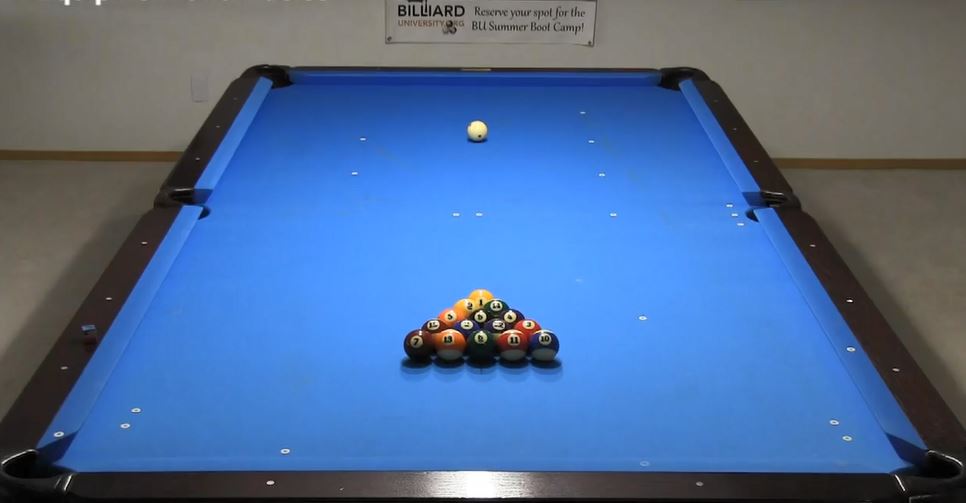
These are “self-adhesive hole reinforcement labels” (AKA “little white donuts” or “little stickies”). They are used primary for the Billiard University (BU) Playing-Ability-Exam drills, but I also use them when working with students when working on certain types of shots and techniques.
What’s in your pool case?
- Predator P3 (previous) or 9K (current) butt with 12.4mm Revo shaft with a Triangle tip.
- Predator Air Rush 3-piece jump cue.
- Predator BK Rush break cue.
- Predator QR butt extension.
- Balance Rite joint extension.
- Taom Pyro or Predator Pure chalk (playing cue) and Master chalk (break and jump cue).
Is it true you own the pool table previously owned by Robert Byrne?
Yes. I purchased it from him in July, 2016, a few months before he passed away. It is a 9′ Olhausen that I had re-clothed with Simonis “Tournament Blue” 860HR. I cherish this table because Robert Byrne was a hero of mine. He set the “gold standard” for billiards instruction.

I currently have the table lighted with a hollow-rectangle arena-style multi-LED-panel Tournament LED Pool Table Light.
Here’s a guided tour of my entire home-basement pool room:
How has your look changed over the years?

(from his “The Illustrated Principles of Pool and Billiards” book)
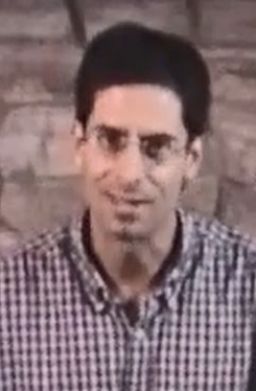
(from his “The Illustrated Principles of Pool and Billiards” DVD)

(from his “System for Aiming With Sidespin” (SAWS) video

(at Instructor Summit)


